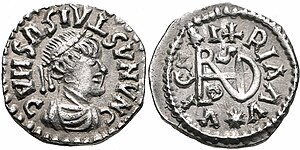
Back Gepide Afrikaans Chepidas AN غبيديون Arabic Xépidos AST Gepidlər Azerbaijani Гепіды BE-X-OLD Гепиди Bulgarian Gèpides Catalan Gepidové Czech Гепидсем CV
Kingdom of the Gepids | |||||||||||||
|---|---|---|---|---|---|---|---|---|---|---|---|---|---|
| 454–567 | |||||||||||||
 Gepid kingdom in Europe following the end of the Western Roman Empire in 476 AD | |||||||||||||
| Common languages | East Germanic (possibly Gothic) among elite. | ||||||||||||
| Religion | Germanic paganism, Arianism (among elite) | ||||||||||||
| Government | Monarchy | ||||||||||||
| King | |||||||||||||
• c. 454 | Ardaric | ||||||||||||
• c. 560-567 | Cunimund | ||||||||||||
| History | |||||||||||||
• Ardaric established an independent Gepid kingdom following the Hunnic defeat at the Battle of Nedao | 454 | ||||||||||||
| 567 | |||||||||||||
| |||||||||||||
| Today part of | Romania, Hungary, Serbia | ||||||||||||


The Gepids (Latin: Gepidae, Gipedae; Ancient Greek: Γήπαιδες, romanized: Gḗpaides) were an East Germanic tribe who lived in the area of modern Romania, Hungary, and Serbia, roughly between the Tisza, Sava, and Carpathian Mountains. They were said to share the religion and language of the Goths and Vandals.
They are first mentioned by Roman sources in the third century. In the fourth century, they were among the peoples incorporated into the Hunnic Empire, within which they formed an important part. After the death of Attila, the Gepids under their leader Ardaric, led an alliance of other peoples who had been in the empire, and defeated the sons of Attila and their remaining allies at the Battle of Nedao in 454. The Gepids and their allies subsequently founded kingdoms on the Middle Danube, bordering on the Roman Empire. The Gepid Kingdom was one of the most important and long-lasting of these, centered on Sirmium, and sometimes referred to as Gepidia.[2] It covered a large part of the former Roman province of Dacia, north of the Danube, and compared to other Middle Danubian kingdoms it remained relatively uninvolved with Rome.
The Gepids were defeated by the Lombards and Avars a century later in 567, when Constantinople gave no support to them. Some Gepids joined the Lombards in their subsequent conquest of Italy, some moved into Roman territory, and other Gepids still lived in the area of the old kingdom after it was conquered by the Avars.
Few archaeological sites remain that can be attributed to them with certainty. After their settlement of the Carpathian Basin, their population was mostly centred on the Someș and Körös rivers, but they did not intermingle with other nations.[3]
- ^ CNG Coins
- ^ Jordanes, Getica, XII.74: Haec Gotia, quam Daciam appellavere maiores, quae nunc ut diximus Gepidia dicitur. Rough translation: "This Gothia, which our ancestors called Dacia, we now call Gepidia."
- ^ "A gepidák rövid története" [Short history of the Gepids]. Gepida (in Hungarian). 2024.